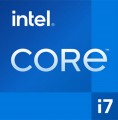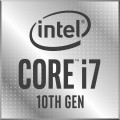Code name
This parameter characterizes, firstly, the technical process (see above), and secondly, some features of the internal structure of processors. A new (or at least updated) codename is introduced to the market with each new CPU generation; chips of the same architecture are "coevals", but may belong to different series (see above). At the same time, one generation can include both one and several code names.
Here are the most common Intel codenames today:
Cascade Lake-X (10th gen),
Comet Lake (10th gen),
Comet Lake Refresh (10th generation),
Rocket Lake (11th generation),
Alder Lake (12th generation),
Raptor Lake (13th generation),
Raptor Lake Refresh (14th generation).
For AMD, this list includes
Zen+ Picasso,
Zen2 Matisse,
Zen2 Renoir,
Zen3 Vermeer,
Zen3 Cezanne,
Zen4 Raphael,
Zen4 Phoenix and
Zen5 Granite Ridge.
Clock speed
The number of cycles per second that the processor produces in its normal operating mode. A clock is a single electrical impulse used to process data and synchronize the processor with the rest of the computer system. Different operations may require fractions of a clock or several clocks, but anyway, the clock frequency is one of the main parameters characterizing the performance and speed of the processor — all other things being equal, a processor with a higher clock frequency will work faster and better cope with significant loads. At the same time, it should be taken into account that the actual performance of the chip is determined not only by the clock frequency, but also by a number of other characteristics — from the series and architecture (see the relevant paragraphs) to the number of cores and support for special instructions. So it makes sense to compare by clock frequency only chips with similar characteristics belonging to the same series and generation.
TurboBoost / TurboCore
The maximum processor clock speed that can be reached when running in Turbo Boost or Turbo Core overclocking mode.
The name "Turbo Boost" is used for the overclocking technology used by Intel, "Turbo Core" for the solution from AMD. The principle of operation in both cases is the same: if some cores are not used or work under a load below the maximum, the processor can transfer part of the load from the loaded cores to them, thus increasing computing power and performance. Operation in this mode is characterized by an increase in the clock frequency, and it is indicated in this case.
Note that we are talking about the maximum possible clock frequency — modern CPUs are able to regulate the operating mode depending on the situation, and with a relatively low load, the actual frequency may be lower than the maximum possible. See "Clock frequency" for the general meaning of this parameter.
TurboBoost Max 3.0
Processor clock speed when running in TurboBoost Max 3.0 overclocking mode.
This mode is a kind of add-on over the original Turbo Boost (see above). The basic principle of its operation is that the most critical and "heavy" tasks are sent for execution to the fastest and most unloaded processor cores. This provides additional optimization of the CPU and increases its speed. As in normal Turbo Boost mode, the clock speed increases when using this function, so it is indicated separately.
Multiplier
The coefficient on the basis of which the value of the processor clock frequency is displayed. The latter is calculated by multiplying the multiplier by the system bus frequency (see System bus frequency). For example, with a system bus frequency of 533 MHz and a multiplier of 4, the processor clock speed will be approximately 2.1 GHz.
PCI Express
Universal interface for connecting internal peripherals. Provides generally higher speeds than SATA. In fact, the supported data transfer rate may be different — depending on the version of the interface and the number of lines (data transmission channels).
Version 3.0 provides speeds of about 1 GB/s per lane,
PCI-E 4.0 about 2 GB/s per lane, and
5.0 up to 4 GB/s per lane.
Passmark CPU Mark
The result shown by the processor in the Passmark CPU Mark test.
Passmark CPU Mark is a comprehensive test that checks not only the gaming capabilities of the CPU, but also its performance in other modes, based on which it displays the overall score; this score can be used to fairly reliably evaluate the processor as a whole.
Geekbench 4
The result shown by the processor in the test (benchmark) Geekbench 4.
Geekbench 4 is a comprehensive cross-platform test that allows, among other things, to determine the efficiency of the processor in various modes. At the same time, according to the developers, the verification modes are as close as possible to various real tasks that the processor has to solve. The result is indicated in points: the more points — the more powerful the CPU, while the difference in numbers corresponds to the actual difference in performance ("twice the result — twice the power").
Note that the benchmark in Geekbench 4 is the Intel Core i7-6600U processor with a clock frequency of 2.6 GHz. Its power is estimated at 4000 points, and the performance of other tested CPUs is already compared with it.
Max. DDR4 speed
The highest frequency of DDR4 RAM modules that the processor is compatible with.
A higher frequency of memory modules, on the one hand, increases the speed of their work, on the other hand, it puts forward increased requirements for the processing power of the processor. Therefore, modern CPUs have limitations on the frequency of "RAM".
The DDR4 standard was introduced in 2010 (the final version — in 2012) as the successor to the popular DDR3.

